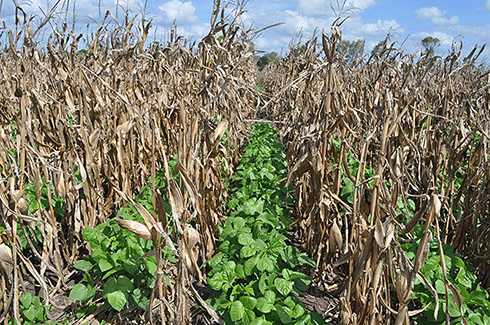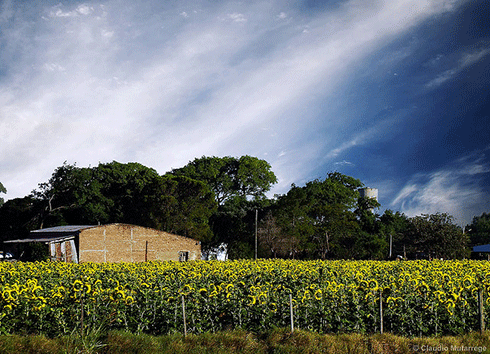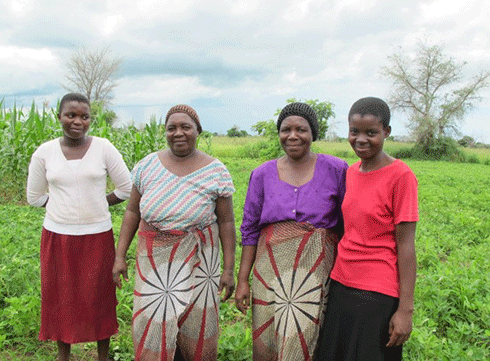
|
Published: 6 August 2014
Food security and the role of ‘sustainable intensification’
Sustainable intensification is the new holy grail for agriculture in a food-insecure world. What does it mean, and how are Australian scientists pursuing it here and abroad?

|
|
Relay cropping trial at Gatton, Queensland. Relay cropping involves sowing a second crop into a standing crop before the harvest of the first crop – here it is mungbeans into maize. Credit: QAAFI
|
‘Sustainable intensification’ is a term used to describe farming practices that increase production while minimising negative side effects, such as environmental impacts. These practices might, for example, avoid the need to expand the area required for farming.
The concept is figuring large in current discussions about agriculture’s role in achieving food security. It’s now a widely held view that global food demand is outstripping production and that serious increases in production are required to stave off food shortages. Take this paragraph from the opening section of a recent article in the journal Field Crops Research :
‘... global agricultural production must increase up to 70 per cent to keep pace with global food demand driven by population and income growth (Bruinsma, 2009; Van Ittersum et al., 2013). This agricultural challenge needs to take into account environmental concerns, i.e. increase grain production while maintaining farm sustainability (Monzon et al.)...’
Many practices come under the banner of sustainable intensification. Examples include increasing weeding frequencies; fine-tuning the timing of crop sowing to maximise the capture and use of resources (rain, heat, sunlight) available to crops; increasing the efficiency of fertiliser through changes in timing and placement; and adopting stubble retention practices and reduced tillage to conserve soil moisture and prevent erosion.
Relay cropping
In Australia’s northern grain growing region (encompassing northern NSW and SE Queensland), trials are underway to develop a sustainable intensification option for maize cropping that uses a practice called relay cropping.
The trials are part of a program known as the ‘Sustainable Intensification of maize, legume farming systems for food security in eastern and southern Africa’ (SIMLESA), funded by the Australian Centre for International Agriculture Research (ACIAR).
Relay cropping involves sowing a second crop into a standing crop before the harvest of the first crop. In this case, mungbeans are sown into a standing maize crop well before the time of harvest of the maize crop.
Associate Professor Daniel Rodriguez of the Queensland Alliance for Agriculture and Food Innovation (QAAFI) is leading this project.

|
| Pampas region, Argentina. The relay cropping trialled at Gatton has been adapted from techniques used in this region, where climate and soils are similar. |
‘In this summer-dominant rainfall environment, growers tend to grow a single crop a year,’ says Assoc. Prof. Rodriguez.
‘With a summer crop such as maize, the crop is cultivated during the time of the year when we have the most rain. After maturity the crop takes a long time to be dry enough the point where it can be harvested.
‘It means that if you want to intensify crop production, either you have to wait till next season to plant another crop, or you have to plant a crop immediately after you harvest the maize, at a time of the year when the radiation, temperature and rainfall are starting to decline.’
Adapted from the Pampas region of Argentina, where the climate and soils are similar, the relay cropping technique aims to increase rainfall use as well as maximise the use of other available plant resources such as sunshine, temperature and soil nutrients.
‘What we’re trying to do is to overlap the cycle of these two crops a little, so that the second crop can be planted at more favourable conditions – higher temperature, higher radiation, and higher rainfall,’ says Assoc. Prof. Rodriguez.
‘If we can get a legume crop sown down in between maize rows, at about the time the maize reaches physiological maturity (grains are fully formed and yield is defined), we are gaining up to 2 months of the season.’
In addition relay cropping appears to improve productivity, with relay-cropped mungbean crops producing 20–40 per cent more than sole-cropped mungbeans. One of the reasons may be improved biological pest control. The micro-climate provided by the maize crop canopy seems to support an increased population of beneficial insects that control pests associated with mungbean.
Improved soil fertility is another benefit.‘We are growing a legume crop that can contribute to soil fertility through nitrogen fixation. Nitrogen is one of the high-cost inputs for farmers – they are always trying to find ways to reduce these costs,’ says Assoc. Prof. Rodriguez.
Mapping the yield gap
Dr Zvi Hochman of CSIRO has also been looking at the prospects for sustainable intensification in the northern grain-growing region. He is part of a research team that has surveyed the inputs and yields of 94 farmers over 3.5 years (7 seasons). The average yield of 1.90 tonnes per hectare was 65 per cent of the simulated water and nitrogen-limited yield potential of 2.92 tonnes per hectare.
‘Economically, it is unrealistic to produce more than 80 per cent of what’s possible, but that’s still a huge gap,’ says Dr Hochman.
‘So the next phase is trying to expose the reasons for this. We have a pretty good handle on that already. We know it’s mainly about tweaking existing practices – helping the average farmer to do what the best farmers are doing.’
This ‘tweaking’ can include ‘opportunistic’ farming – responding to the conditions of the season as they develop in terms of decisions about when and what to sow, or how to manage livestock. While this might sound like making farming decisions on an ad-hoc basis, in fact it takes planning.
‘One way we’re achieving this is Yield Prophet, a decision-support system developed by CSIRO that allows farmers to monitor the crop and respond to the season.’
Uses and abuses
With widespread use of the term ‘sustainable intensification’ has come criticism of the way it is used in the context of food security.
Ecologist Joern Fischer points out that it is clearly not enough to address the environmental and agronomic dimensions of food security. Food security is also a fundamentally social problem, involving questions of access to decision making (power), equity, and justice are key.
‘So, unlike for carbon, the “produce first, distribution will look after itself” principle, is fundamentally flawed when it comes to food,’ he writes.
Dr Hochman agrees.
‘Many things must go in the mix when talking about food security – production and equity in distribution, and changing patterns of consumption are also important factors.
‘You need to address all these to achieve sustainable food production. And you need to address climate change. Its not like you can forget one and focus on the other.’

|
|
Ethiopian farmers participating in an ACIAR-funded project on sustainable intensification of maize-legume systems. Credit: ACIAR
|
In Africa and as part of the SIMLESA program, Assoc. Prof. Rodriguez works across five countries (Ethiopia, Kenya, Tanzania, Malawi and Mozambique) in ways that clearly address these issues. Now in its second phase SIMLESA is working with poorly resourced farmers to sustainably intensify the production of maize–legume–livestock systems.
‘Working primarily with small-scale farmers, we are using participatory approaches that emphasise identifying best-fit technologies given multiple constraints – primarily socio-economic, markets and environmental,’ says Assoc. Prof. Rodriguez.
‘In a stepping-stones approach this means identifying the best suited technologies that match farmers’ needs and investment or adoption capacity.
‘For example, for the least resource-endowed farmers, we aim to increase their yields by demonstrating how the adoption of simple and inexpensive agronomic practices could help lift productivity – i.e. using the same level of inputs or resources that they have. For the better-endowed farmers with capacity for investing in fertilisers, hybrid seed and herbicides, more complex packages are developed.’

